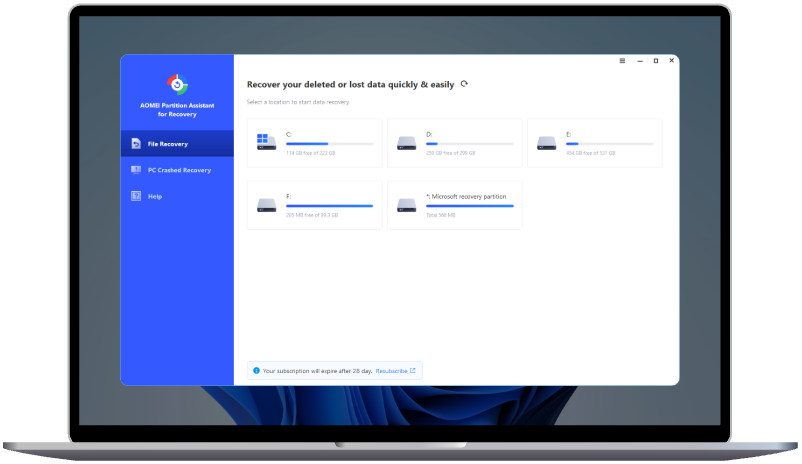Is It Possible to Recover Deleted Photos from recently deleted?
Is it possible to recover deleted photos? It is certainly available to find lost pictures back. This article contains five feasible recovery ways to help you realize photo recovery from different conditions.
Is it possible to recover deleted photos?
Yes, it is possible to recover deleted photos from years ago or under certain conditions. When you delete a photo, it doesn’t instantly disappear from your storage device. Instead, the file is marked as deleted, but the actual data often remains on the device until it is overwritten by new files. This means that if you act quickly, recovery is possible.
However, the success of photo recovery depends on various factors, including the type of storage device, how long ago the photos were deleted, and whether new data has overwritten the deleted files. The method of deletion also plays a role; for instance, photos deleted from the recycle bin on a computer might be easier to recover than those permanently wiped using specialized software.
Recovery can be more complex in certain cases, such as when the storage medium is physically damaged, or if it's a mobile device with automatic syncing features that might overwrite or erase the data from the cloud. Ultimately, while recovery is often feasible, the likelihood of success decreases as time passes and more data is written to the device.
How to recover deleted photos from recently deleted
No matter why you lose your cherished pictures, you can refer to the following methods to get them back.
Method 1. From the Recycle Bin
When photos are deleted, they are often sent to the Recycle Bin instead of being permanently erased. If the Recycle Bin hasn't been emptied, you can easily restore your photos:
The Recycle Bin is the first place to check for deleted images on a Windows computer. It serves as a temporary storage folder for recently deleted files. Photos stay in the Recycle Bin for a set period or until the bin is emptied.
Step 1. Open the Recycle Bin on your desktop.
Step 2. Locate the deleted photos you want to recover.
Step 3. Right-click the photos and select Restore.
The photos will be returned to their original location on your system.
Method 2. From Backup and Restore
If you regularly back up your files using Windows' built-in Backup and Restore feature, you can recover deleted photos from your backup:
Step 1. Go to the Control Panel, and select System and Security > Backup and Restore in turn.
Step 2. Click Restore my files.
Step 3. Click Browse for files to choose the file you want to recover, and then click Next.
Step 4. Specify the saving path for your recovered file, and click Restore.
Method 3. Using a photo recovery software
Professional data recovery tools like AOMEI Partition Assistant for Recovery can restore deleted images in formats such as PNG, JPG, JPEG, TIFF, BMP, and many others, even after a long period. Whether it's from a Windows PC, external hard drive, USB drive, or SD card, this software can help recover lost photos.
✍ Key features:
▸ Recover photos from emptied Recycle Bin, memory cards, USB flash drives, SD cards, digital cameras, and camcorders.
▸ Automatically repair corrupted JPEG/PNG files during the recovery process.
▸ Support recovery from sudden deletions, formatting, hard drive corruption, virus attacks, and system crashes.
▸ Restore photos from various devices including both Windows 11/10/8/7 and Windows Server computers.
Step 1. Install and launch AOMEI Partition Assistant for Recovery. Choose the exact partition or disk where your data lost and click Scan.
Step 2. Then, the recovery tool start to scan and search. lt will execute the “Quickly Scan" first for finding your deleted data fast, and then execute the “Deep Scan" for searching other lost data.
Step 3. Once the scan is completed, all deleted files, recycle bins and other missing files will be displayed. Please select the file you would like to recover and then click "Recover".
Step 4. Then, select a folder path to save your recovered files.
Step 5. Wait patiently for this process of recovery to end.
Method 4. Via Windows File History
If you have enabled File History on your Windows PC, you can recover deleted photos from previous versions:
Step 1. Go to Control Panel > System and Security and click File History.
Step 2. Select Restore personal files. It will open file history recovery window.
Step 3. Click the left arrow to locate your deleted files, and click the Restore to original location icon to restore deleted files from Recycle Bin.
Method 5. With Windows File Recovery tool
Windows File Recovery is a free tool from Microsoft that allows you to recover files that have been permanently deleted:
Step 1. Download and install Windows File Recovery on your computer from Microsoft Store.
Step 2. Open the USB hard drive’s Properties, check its File System, and choose the mode you should use to recover data.
Step 3. Open Windows File restore and type in the restore command line you created.
For instance, winfr F: D: /extensive /n *.jpg is the correct command line to bring back JPG files that were deleted for a while from the source USB drive (F drive) to the target drive (D drive).
Conclusion
As shown, there are various methods to recover deleted photos, regardless of the device or computer they were stored on. While it's important to take preventive measures to avoid photo loss, if you're ever in a situation where recovery is needed, AOMEI Partition Assistant for Recovery can restore your pictures when other solutions fall short.

